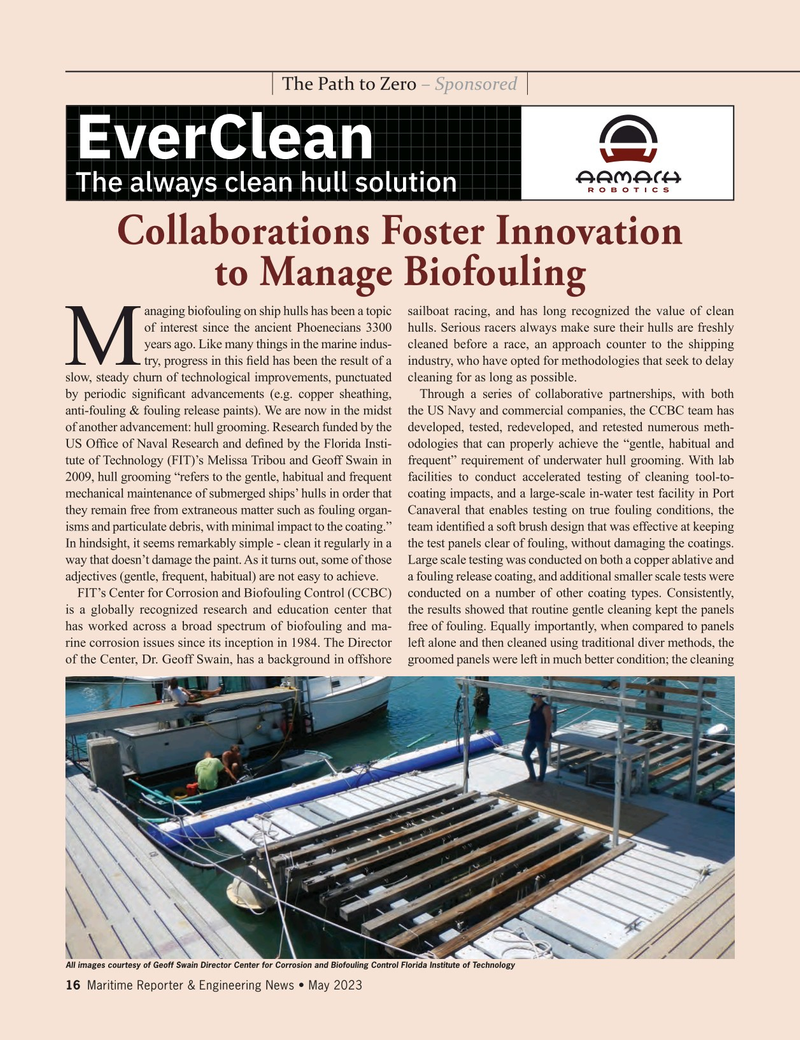
Page 16: of Maritime Reporter Magazine (May 2023)
Green Ship Technologies
Read this page in Pdf, Flash or Html5 edition of May 2023 Maritime Reporter Magazine
The Path to Zero – Sponsored
EverClean
The always clean hull solution
Collaborations Foster Innovation to Manage Biofouling anaging biofouling on ship hulls has been a topic sailboat racing, and has long recognized the value of clean of interest since the ancient Phoenecians 3300 hulls. Serious racers always make sure their hulls are freshly years ago. Like many things in the marine indus- cleaned before a race, an approach counter to the shipping
M try, progress in this ? eld has been the result of a industry, who have opted for methodologies that seek to delay slow, steady churn of technological improvements, punctuated cleaning for as long as possible. by periodic signi? cant advancements (e.g. copper sheathing, Through a series of collaborative partnerships, with both anti-fouling & fouling release paints). We are now in the midst the US Navy and commercial companies, the CCBC team has of another advancement: hull grooming. Research funded by the developed, tested, redeveloped, and retested numerous meth-
US Of? ce of Naval Research and de? ned by the Florida Insti- odologies that can properly achieve the “gentle, habitual and tute of Technology (FIT)’s Melissa Tribou and Geoff Swain in frequent” requirement of underwater hull grooming. With lab 2009, hull grooming “refers to the gentle, habitual and frequent facilities to conduct accelerated testing of cleaning tool-to- mechanical maintenance of submerged ships’ hulls in order that coating impacts, and a large-scale in-water test facility in Port they remain free from extraneous matter such as fouling organ- Canaveral that enables testing on true fouling conditions, the isms and particulate debris, with minimal impact to the coating.” team identi? ed a soft brush design that was effective at keeping
In hindsight, it seems remarkably simple - clean it regularly in a the test panels clear of fouling, without damaging the coatings. way that doesn’t damage the paint. As it turns out, some of those Large scale testing was conducted on both a copper ablative and adjectives (gentle, frequent, habitual) are not easy to achieve. a fouling release coating, and additional smaller scale tests were
FIT’s Center for Corrosion and Biofouling Control (CCBC) conducted on a number of other coating types. Consistently, is a globally recognized research and education center that the results showed that routine gentle cleaning kept the panels has worked across a broad spectrum of biofouling and ma- free of fouling. Equally importantly, when compared to panels rine corrosion issues since its inception in 1984. The Director left alone and then cleaned using traditional diver methods, the of the Center, Dr. Geoff Swain, has a background in offshore groomed panels were left in much better condition; the cleaning
All images courtesy of Geoff Swain Director Center for Corrosion and Biofouling Control Florida Institute of Technology 16 Maritime Reporter & Engineering News • May 2023
MR #5 (1-17).indd 16 5/5/2023 3:16:13 PM

 15
15

 17
17
